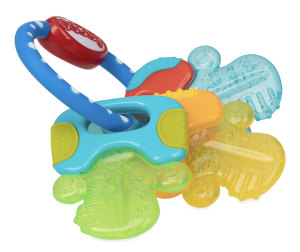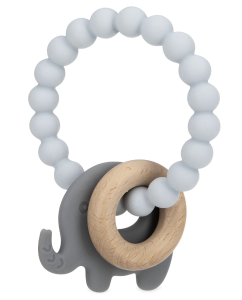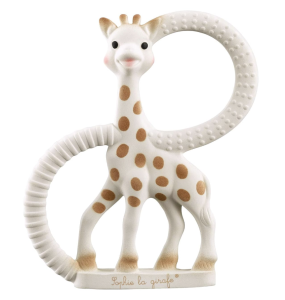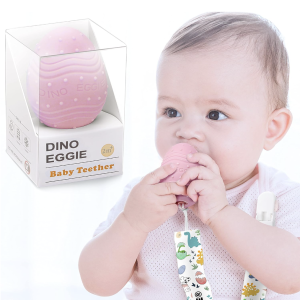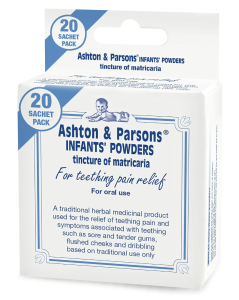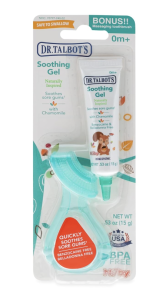When your baby starts teething, chances are you'll know about it. A teething rash, red cheeks, excess dribbling, and general irritability are all signs of teething in babies and toddlers. But how long does teething last? And how can you relieve the symptoms?
Babies usually have their full set of teeth by age three. During those first three years, whenever a new tooth comes in, there's potential for teething symptoms. Fortunately, there are plenty of things you can try which might make it a bit easier to get through – for baby and for you! These include:
- Gels
- Powders
- Toys
- Rings
- Mittens
Keep reading for recommendations for products that other parents swear by, plus answers to all your teething questions. You can read up on every aspect of your child's oral health with our entire collection dedicated to dental care for babies and children.
In This Article
When do babies start teething?
Most babies start teething at about six months of age and have their first teeth by their first birthday. This baby teething chart shows roughly what to expect. You can read our baby teeth guide if you want to know more about when baby's teeth will appear, and in what order.
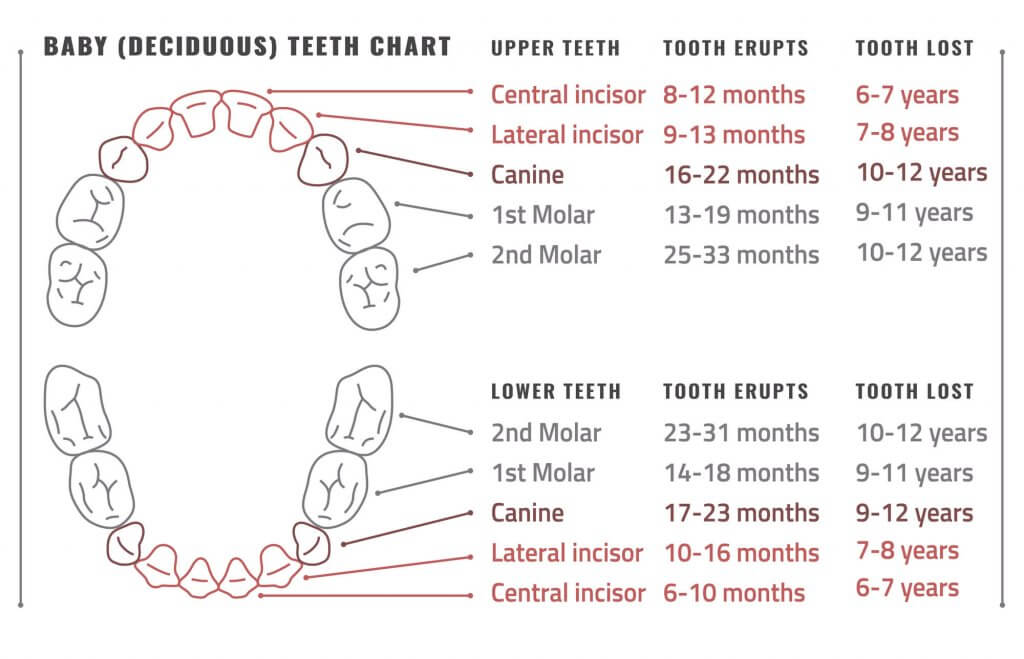

However, there is no fixed timeline for when teeth start to appear (babies can even be born with teeth), and teething can be equally unpredictable.
Some teething babies don't seem at all bothered by their new teeth erupting, whereas for others it causes significant discomfort. Certain teeth will probably come through more easily than others. And the symptoms of teething might appear days or weeks before the tooth itself pops through.


All of this uncertainty can leave you analysing every sign and wondering when those little chompers will finally emerge! Rest assured, your baby's teeth will get there when they are ready.
How long does teething last for?
Most children have their full set of baby teeth by age three. Don't worry – this doesn't mean they'll be teething all the way through until then. In fact, teething pain usually comes in bursts. It lasts for a few days at a time before easing again. It can feel like a lot longer than this at the time though, especially if your infant is having trouble sleeping.
Often the first teeth – the central incisors and lateral incisors – are the worst. That said, the larger biting surface of the first molars and second molars means they may also be quite painful and cause the gums to look bruised during molar teething.
Generally, baby will feel a lot better soon after the tooth has broken through the gum.
This study into the side-effects of teething found that the most significant symptoms were present up to four days before and three days after a tooth emerged.
What are the first teething symptoms?
If you're keenly awaiting the arrival of your baby's first tooth, there are plenty of things to look out for. Signs baby is teething include red, swollen gums and increased dribbling. Also look for:
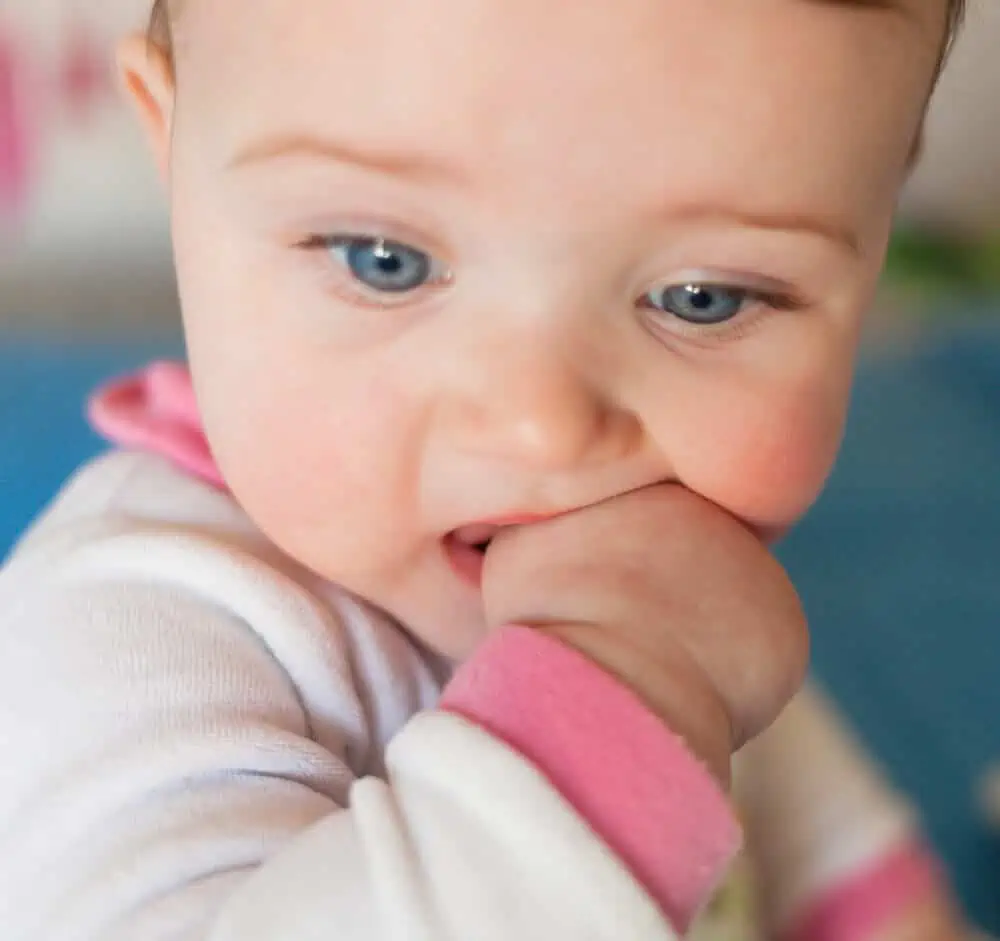

- Flushed cheeks, sometimes just on one side
- Rubbing their ear
- Chewing or sucking on whatever is available
- Feeding/eating less than normal
- Waking more often than usual
- General irritability or restlessness
Don't expect to see all of these things at once, and don't be surprised if your baby shows no teething signs at all. As we've said, everyone's experience is different.
Baby teething rash
Although not a direct result of first teeth coming through, all that excess dribble can cause a rash around the mouth, chin, and even baby's neck. The best solution is to wipe their face whenever you notice it is wet from drool, but be very gentle so as not to irritate the skin further.
A good stock of bandana teething bibs can come in handy here – not only do they stop baby's neck getting too soggy but you'll always have something on hand to wipe their mouth with. Look for ones like these with a triple layer lining and 100% cotton for extra absorbency and less skin irritation.
You can also use a barrier cream like Vaseline to protect the skin at nighttime or if you're going out in the cold.
Can teething cause a fever?


An analysis of 10 studies found that although teething can cause a slight rise in body temperature for a couple of days, it's usually not high enough to be considered a fever (38° C or 100.4° F).
In fact, the misconception that teething causes a fever could lead parents to overlook a more serious medical problem that might require other treatment. If your child does have a fever, follow this advice from the Mayo Clinic about whether to seek medical care.
Similarly, there is no evidence that teething causes diarrhea or vomiting. Some people think it's a result of baby swallowing so much extra drool, but it could be a sign of illness.
How to help a teething baby
There are various ways to soothe pain from milk teeth coming through. You can buy a selection of baby teething rings and other toys, but you might find that your baby is just as happy chewing on your finger or a cold piece of food. You might also want to have some teething powder, gel, or other pain medicine on hand for when nothing else seems to be helping.
Have a look through these suggestions so you're prepared with a few different things to try when the moment strikes.
Something to chew on
First of all, you can try just rubbing a clean finger over your baby's gums, or letting her chew on it for a while. The counter-pressure can provide some relief from the first tooth pushing inside the gum.
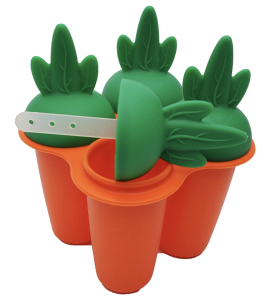

Giving your infant some chilled food to chew is also very effective, but make sure it's safe for their age. Chilled pieces of cucumber or banana are great, and toddlers can have carrot or apple to gnaw on. Even if your baby has only just started solids, some cold fruit puree or yoghurt might help.
Some parents like to freeze pieces of fruit or give their teething baby pieces of ice or frozen yoghurt. Food straight from the freezer can be so cold that it damages baby's mouth, so approach this method with caution. If you do want to try it, these reusable popsicle molds are the perfect size for little hands and mouths. Puree some fruits of your choice to make a tasty and soothing treat. They are cleverly designed to catch any drips, too!
Teething rings and toys
If baby is bored of chewing on your fingers (or you need them for something else), a teething toy can provide a welcome distraction. You'll find these in all shapes, sizes, colours and materials, but the main thing is that it's easy for little hands to hold and has surfaces suitable for chewing. Here are a few of the best which are just a click away on Amazon.
Nuby Icy Bite Keys Teether toy features three brightly coloured gel-filled ‘keys' with multiple textured surfaces. The toy can be cooled in the fridge for some extra teething relief. It's quite light compared to some other teethers, so is easy for babies to hold from around 3-4 months.
On the downside, some reviewers say it's fiddly to clean. Others think it would be better if the keys could be removed from the ring and used individually.
For a toy that blends modern Nordic aesthetics, soft silicone and crochet beads and natural beech wood, there's this Montessori wooden elephant teething ring.
The silicone beads are FDA approved, and the wood is made of hand-polished natural beech wood with organic virgin olive oil. It's connected with double string for safety and can be wiped clean and re-sealed with olive oil as needed.
Other products are available which combine wooden and silicone beads in more complex designs. You can even make your own with a DIY teether kit containing a variety of beads, rings and clasps.
Finally, the popular Sophie the Giraffe range of teething toys are all-natural, made from rubber and decorated with food-grade paint. This teething ring features the original giraffe with the addition of two textured handles, making it easier to grab and chew.
Reviewers suggest this toy is best in the early stages of teething before the teeth actually break through the gums. Some report that after a few months of use, the material starts to deteriorate. Still, it is a highly rated product and seems to be the go-to for many parents.
Another popular option is the teething egg. This egg is made from 100% premium quality food-grade silicone, and it has an adorable dinosaur egg shape. There are bumpy textures all over the surface that help massage your baby's sore and swollen gums.
This toy is all one piece, so you don't have to worry about accidental swallowing. It also has a built-in shaker for an entertaining rattle sound. And you'll never have to worry about losing it, because it clips right on to your baby's clothes, stroller or car seat. One happy customer says:
“Great quality, and baby loves this! Couldn’t ask for a more perfect teething product!”
Teething mittens
Younger babies may struggle to hold toys, in which case a teething mitten is a great alternative. These fasten around the wrist so there's no holding required and – bonus – they can't be dropped on the floor. A mitten could also be a good solution if your infant has taken to chewing or sucking their fingers.
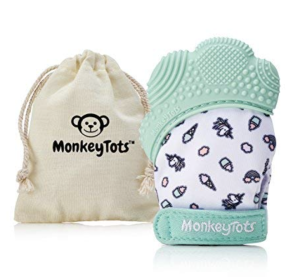

The MonkeyTots® Teething Mitten is a high-quality product that's been thoughtfully designed with different textures and a crinkle patch to keep baby interested. It comes with a handy carry pouch and a milestone card, as well as a teething eBook you can download. This makes it a great baby shower gift, too!
Reviewers say they are impressed with the quality of the product and it's easy to machine wash. Of course, it gets soggy after being chewed on for a while, so some parents have bought two or three so there's always a clean one available.
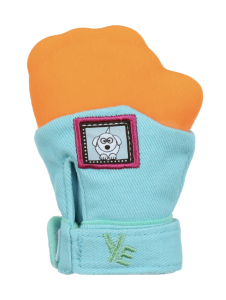

A popular alternative is the Yummy Mitt teething mitten. Made from cotton and food-grade silicone, it features a fun design and crinkly ears to keep your child entertained. It also has an adjustable hook and loop closure and is machine washable.
One benefit of this mitt is that the side teethers are very thin. Even young babies should find them easy to chew on.
“Absolutely hands down the best teething mitt available. My son uses it everyday. Now my nephew does too. It’s gentle on sensitive skin, it’s easy to use and easy to clean. The placement of the different pieces are perfect.”
View this product in action in the video below:
Teething powder
Teething powders are homeopathic remedies which use traditional herbal ingredients to soothe baby teething symptoms. You tip the powder into baby's mouth onto the tongue, where it dissolves and gets to work.
Teething granules are usually suitable for children aged 3-4 months and over.
Ashton & Parsons Teething Powder
Sold in the UK for over 150 years, but beloved by American parents as well, Ashton & Parsons Teething Powder contains tincture of Matricaria, an ingredient extracted from German chamomile flower heads. This has antibacterial and anti-inflammatory properties, and many parents are amazed at the instant soothing effects it has on their infants.
“My great grandson loved these powerful powders, it soothed his gums right away and he was back to laughing again.”
This powder can be given once an hour if needed, but a maximum of six times in 24 hours.
Teething gels
Teething gels are applied directly onto sore gums to relieve the pain of teething. Some have a mild numbing effect, whereas others rely on soothing ingredients. Orajel is perhaps the best-known brand in the US, but here are some others that come highly rated. Note that these gels are generally suitable for infants aged 3-4 months and up. Speak to a pharmacist or doctor before using them any earlier.
Dr. Talbot's Natural Gel
This soothing gel for sore gums is formulated with natural ingredients like chamomile and is free of Benzocaine. The natural makeup means you don't have to worry about your child swallowing this gel, as they won't be exposed to harmful chemicals.
With this gel you also get a messaging toothbrush with a textured design that will gently massage your baby's gums.
One very happy parent says:
“Best. Stuff. Ever!!! Seriously a lifesaver and safe to use after 4 months when they start cutting most teeth. My LO hates the taste but when teeth hurt calms down almost immediately after applying this stuff (sometimes asleep in minutes after screaming and then getting gel applied). It’s a teething must-have!!!”
Zarbee's Gum Massage Gel
This is another natural teething gel that is also free from benzocaine and belladonna. It's plant-based and non-medicated, with soothing ingredients like chamomile and lemon peel.
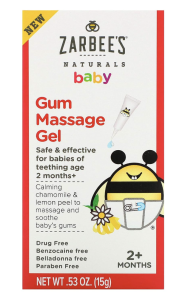

This gel can be used both day and night, a pea-sized drop applied as frequently as needed.
Some of the reviews are indifferent, saying it doesn't do much, but most are similar to this parent's review:
“My 3 month old seems to like it pretty well. She chills out once I rub some on her gums so as long as she's happy, I'm happy 😄”
Other medicines for teething
You can, of course, turn to regular pain relief in the form of paracetamol or ibuprofen, or teething tablets like these ones from Hyland's. This might provide some welcome relief at night in particular, if your baby's teething is disrupting their sleep (and yours).
Always choose a sugar-free product that's suitable for your baby's age, and follow the dosage instructions on the label.
One thing we've deliberately left off this list is the amber teething necklace, bracelets and anklets. Although some parents swear by their pain-relieving properties, there is no scientific evidence that they have any such effect. More importantly, they pose a suffocation and choking hazard. In 2018 the American FDA issued a warning about teething jewellery after one infant was sadly strangled by a necklace while napping and another almost chocked on some beads that had come loose.
Caring for baby's milk teeth
As soon as that first tooth makes an appearance, you're responsible for taking care of it. Get your child used to brushing their teeth in the early months, and you may avoid some struggles later on.
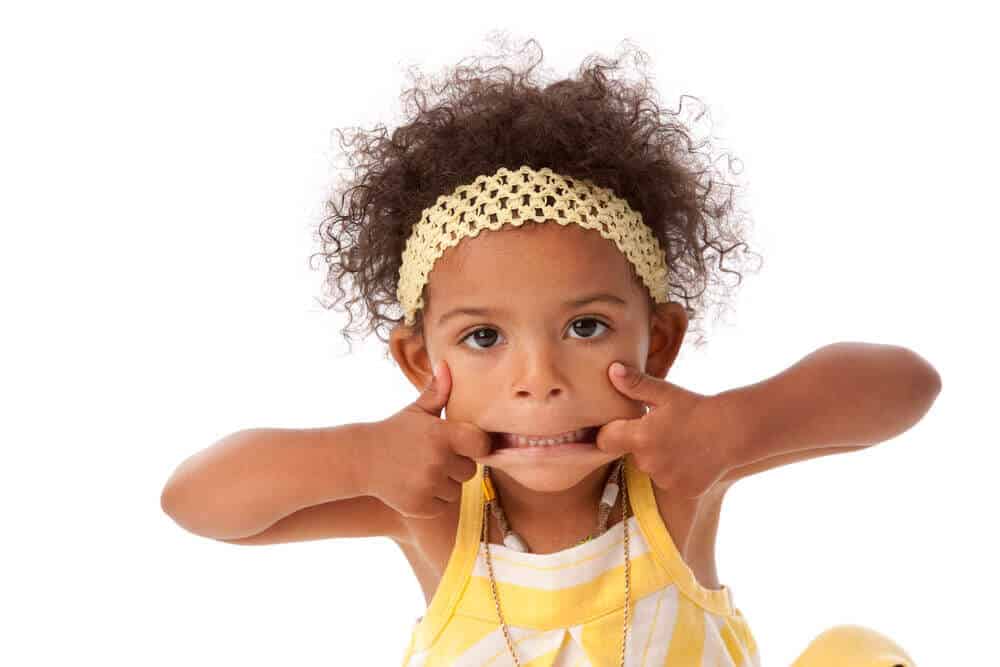

Check out our children's oral health guide to read how to care for your child's teeth and prevent common problems like tooth decay. Not sure how to choose their first toothbrush? No problem – our guide to toothbrushes for babies and children has some great advice.
You should take your baby to their first dental checkup soon, too. The dentist will check that their teeth are healthy and might offer fluoride varnish to give an extra layer of protection. Keep taking them along to regular checkups so that any potential problems can be spotted early on and treated before they develop into anything more serious.
You'll also want to be conscious of pacifier use, to make sure your child doesn't suffer from pacifier teeth further down the road.
Conclusion
Teething symptoms vary, but there are plenty of things to look out for if you think your baby has a new tooth on the way. Teething shouldn't make your baby unwell though, so stay alert for signs they may have an illness that requires medical attention.
There are lots of ways to relieve the pain of teething for babies, and we hope this guide has given you some useful ideas to make these months pass more easily. Try a range of different teething remedies until you find something that gives your little one that much-needed relief.
Oxford Academic: Teething necklaces and bracelets pose significant danger to infants and toddlers. Consulted 10th February 2020.
American Academy of Paediatrics: Signs and Symptoms of Primary Tooth Eruption: A Meta-analysis. Consulted 10th February 2020.
American Academy of Paediatrics: Symptoms Associated With Infant Teething: A Prospective Study. Consulted 10th February 2020.
Science Direct: Matricaria chamomilla. Consulted 10th February 2020.
Mayo Clinic: Fever. Consulted 18th June 2020.





